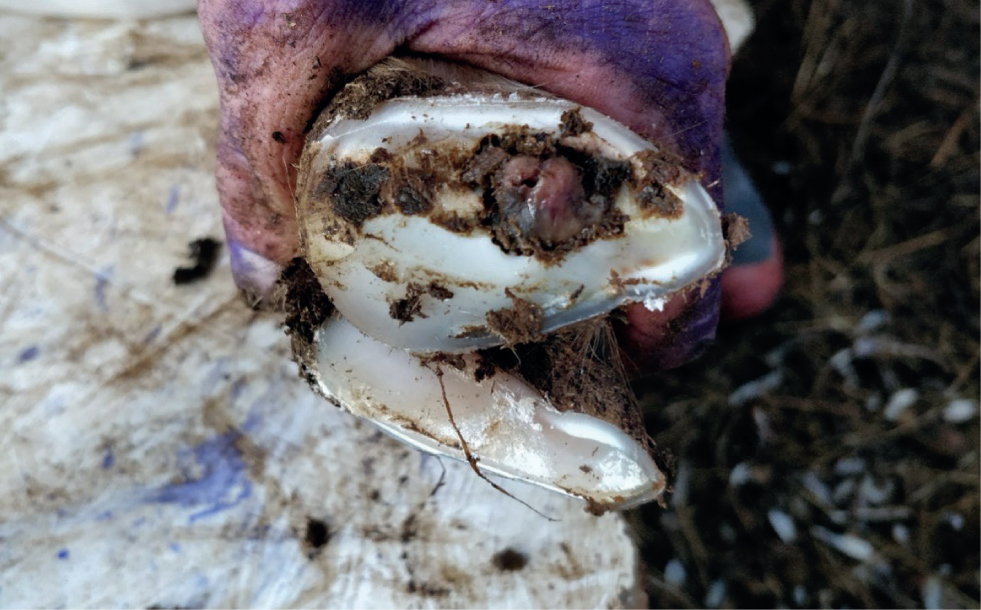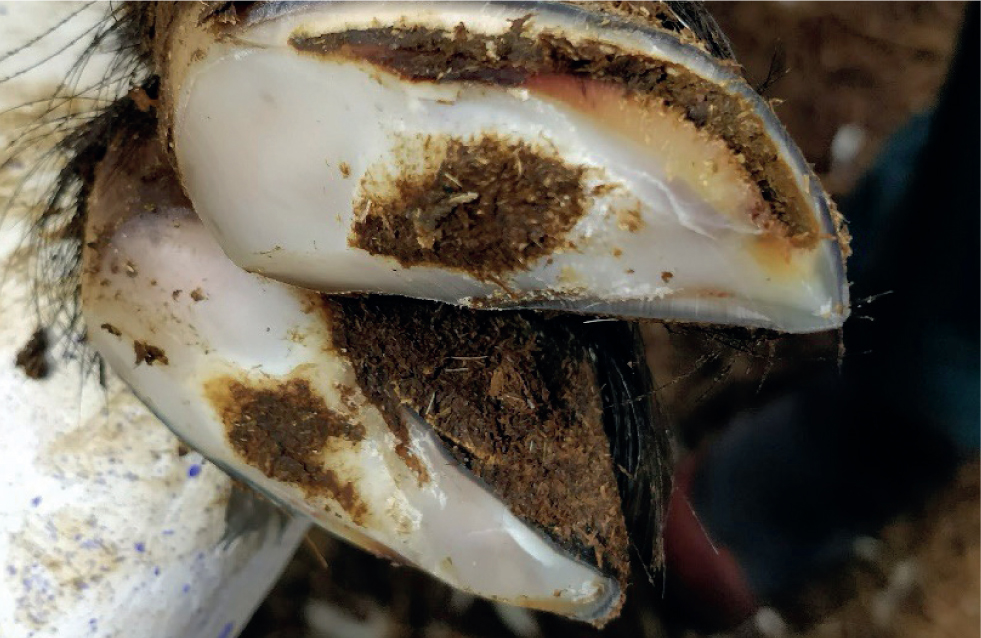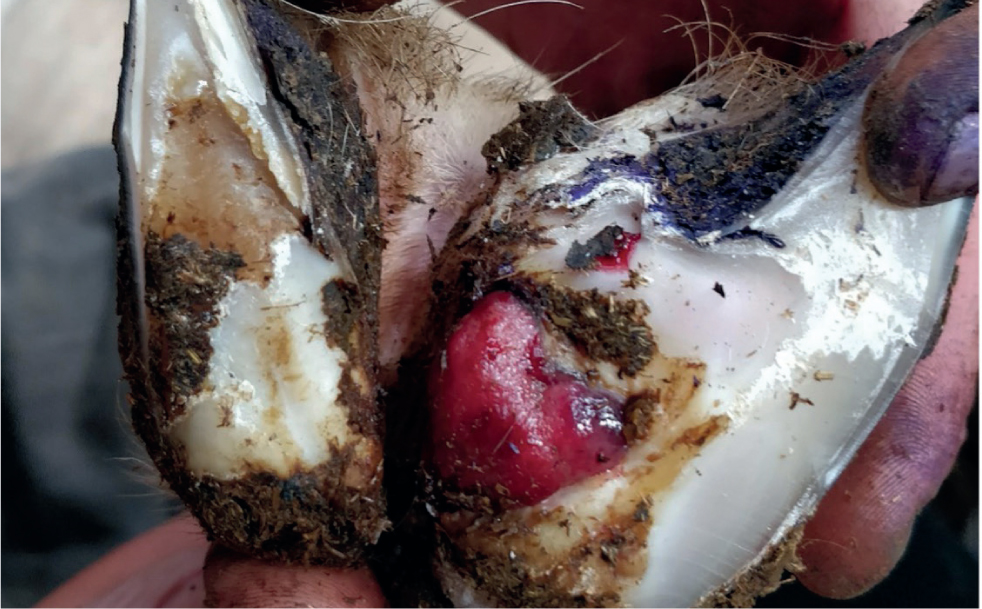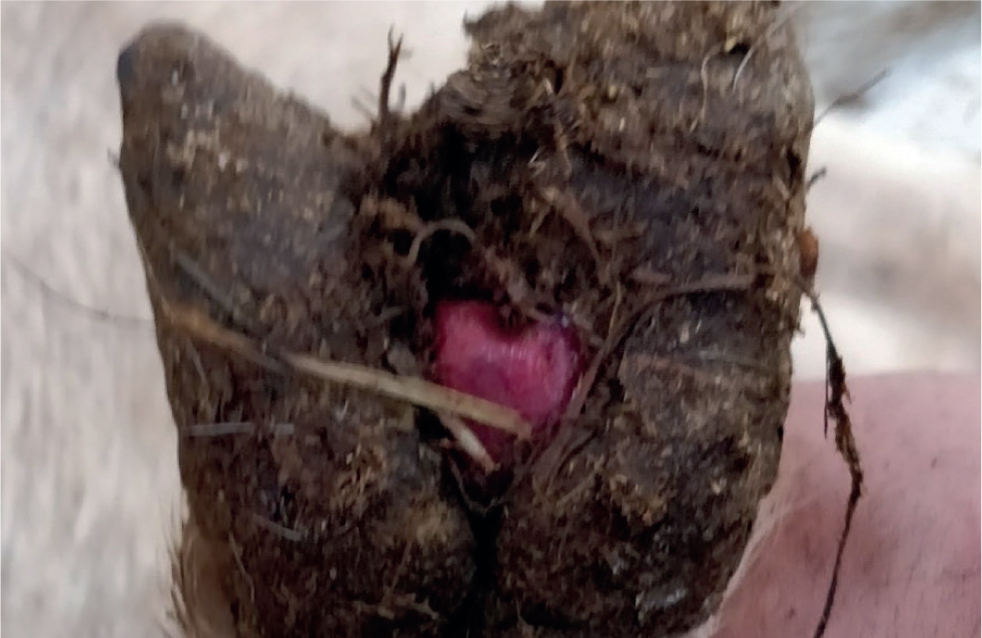Lameness in farmed ruminants is a significant economic and welfare problem: lameness is painful and lame ruminants grow more slowly, produce less milk and become pregnant less easily than their non-lame counterparts (Huxley, 2013; Marcone et al, 2022; Vouraki et al, 2022). Yet lameness is significantly under-studied compared to reproduction and mastitis in cattle, sheep and goats. In addition, goats are significantly under researched across all health areas compared to cattle and sheep, probably because keeping goats is common in resource-poor areas and, even in those areas, they are associated with poverty, while cattle are associated with wealth (Peacock, 2005). Lameness in goats is a major welfare and economic problem for which research is very limited.
In higher income countries, most commercially managed goats are dairy goats and most large-scale high-producing dairy goat farms keep their goats indoors with limited access to pasture (Zobel et al, 2019). This is principally to allow supplementary feeding to maintain high milk yields and to limit the impact of gastrointestinal nematodes (Anzuino et al, 2010). In such systems, goats are usually kept loose housed on soft bedding (such as wood shavings or straw) often with limited access to hard surfaces (Zobel et al, 2019). However, when goats are kept in such environments hoof overgrowth is a constant management issue, as goat hooves continue to grow despite the lack of wear. Therefore, corrective hoof trimming to remove excess horn growth is a common husbandry practice on most large-scale goat farms, and most farms trim goats' hooves every 3–6 months (Hempstead et al, 2021). Despite this frequent trimming, hoof overgrowth remains a significant problem on many farms (Hempstead et al, 2021), which is exacerbated by the lack of data on optimal trimming regimes for housed goats.
Concern is expressed over overgrown claws because they are thought to be associated with lameness. However, in commercial housed goats, the prevalence of overgrown claws far exceeds the prevalence of lame goats, even when goat locomotion is observed. For example, it has been reported that 80% of goats examined have overgrown claws (of which 40% had severe overgrowth), yet only 19% were scored as lame (Anzuino et al, 2010). The same authors reported a correlation between the percentage that were lame and the percentage of severe overgrowth, but this might indicate similar risk factors or general overall poor management, rather than a direct association. More data are needed on the relationship between lameness and hoof overgrowth in goats.
The same is true for the efficacy of hoof trimming. Data on the value of prophylactic trimming and lameness in cattle are limited (Stoddard and Cramer, 2017), but at least data exist. Despite routine foot trimming being used on almost all large-scale dairy goat farms, there are no peer-reviewed studies of its efficacy in preventing overgrown hooves or lameness. One study concluded that hoof trimming every 4 months was not frequent enough to prevent overgrowth, but all goats in their study were trimmed every 4 months (Deeming et al, 2023), so this conclusion is based on high rates of overgrowth in trimmed goats rather than a comparison between trimmed and untrimmed goats. Thus, it is unknown whether routine trimming reduces the risk of either overgrown hooves, or, perhaps most importantly, the risk of lameness.
Locomotion scoring in housed goats
Understanding and researching lameness requires accurate measurement of lameness status. In addition to its value for research, measuring the number of lame goats on a farm is useful for identifying whether or not a lameness problem exists. Locomotion scoring is useful for monitoring a response to control and prevention programmes, and locomotion scores have been developed for sheep and cattle (Kaler and Green 2008; Fabian et al, 2014) as well as for goats (Anzuino et al, 2010). However, as with all other lameness-related issues, locomotion scores are less well-developed in goats than in sheep or cattle (Anzuino et al, 2010).
Most reports of the prevalence of lameness in goats have focused on severe lameness only, following the advice from the Animal Welfare Indicators (AWIN) welfare assessment protocol for goats that ‘due to husbandry constraints and diversity of management and resources at dairy goat farms, it is impossible to follow a standard protocol to identify slight and moderate cases of lameness’ (Battini et al, 2015). This approach will clearly underestimate the impact of lameness on goat welfare. In contrast to the claim in the AWIN protocol, Anzuino et al (2010) were able to identify moderate lameness (defined as a goat with a definite limp on one or more legs, but which bears weight and moves forward freely) in a sample of goats on 24 dairy goat farms that were scored as they exited the parlour after milking. However, the authors commented that they were not aware of any goat locomotion scoring system that identified slightly lame goats and suggested that even their protocol would underestimate the impact of lameness on goat welfare (Anzuino et al, 2010).
Deeming et al (2018) developed a 5-point locomotion score for goats that included a slightly lame category (‘uneven gait’). As with Anzuino et al (2010), they observed goats as they exited the milking parlour but to ease observation, they ensured that goats exited the parlour one at a time. Deeming et al (2018) reported in their sample of 42 goats on one farm that 21 (50%) had an uneven gait, while 6 (14%) were lame (score ≥3). More recently, the 0–3 Agriculture and Horticulture Development Board lameness score designed for cattle was adapted for use on dairy goat farms (Table 1) (Chesterton et al, 2022). That scoring system is effectively the same as that used by Deeming et al (2018), except that it has only two lame categories rather than three. At a farm level, this has little practical significance because a lame goat should be treated as soon as possible, irrespective of whether it is defined as moderately or severely lame.
Table 1. Locomotion scoring system
| Score | Sign of lameness |
|---|---|
| Score 0 | None |
| Score 1 | Slight uneven gait, but no obvious head bobbing |
| Score 2 | Lame on one limb and head bobbing but still weightbearing on the affected limb |
| Score 3 | Lame and i) not weightbearing on one foot or ii) more than one foot lame and walking more slowly than the herd |
Adapted by Chesterton et al (2022) from the Agriculture and Horticulture Development Board lameness score for cattle
Chesterton et al (2022) aimed to score the whole herd after milking (using a tally system and not identifying individual animals). They were able to accurately score goats on 3 out of 4 farms in the study. The distance on the fourth farm between the parlour and the goat housing was not long enough to allow accurate scoring. The authors reported that across two visits on the three farms, 16% of all locomotion scores were from goats that were lame (score ≥2). This was very similar to the proportion of lame goats reported by Deeming et al (2018). However, the proportion of goats reported as having uneven gait was much lower (Chesterton et al, 2022) than that reported by Deeming et al (2018). This suggests that either there is a large variation across farms in the ratio of goats with uneven gait to goats with clinical lameness, or that trying to identify uneven gait in large numbers of goats is not a useful approach – contrary to the conclusion made by Deeming et al (2018) that their scoring system was suitable for use at a large scale.
Locomotion scoring may be a useful management tool at the herd level, but simply identifying how many lame goats there are needs to be supplemented by prompt identification and treatment of those lame goats. In sheep, Kaler and Green (2008) concluded that prompt examination of sheep identified as lame was crucial in determining subsequent lameness prevalence. This approach is also likely to be the best approach on goat farms, ensuring the focus is on prompt identification and treatment of clinically lame goats (score 2 or more in Table 1). Scoring systems such as those used by Deeming et al (2018) and Chesterton et al (2022), could potentially treat goats with an ‘uneven gait’. However, it is unclear what proportion of goats with uneven gait will subsequently become lame. Recent studies in New Zealand on lame cows kept permanently at pasture (Werema, 2022) found that 72% of cows observed as having uneven gait never became clinically lame. Thus, especially if the proportion of goats with uneven gait is as high as suggested by Deeming et al (2018), it is plausible that focussing on goats with an uneven gait will lead to large numbers of goats being examined and treated unnecessarily.
Non-infectious hoof horn lesions in housed goats
In sheep and especially in cattle, identifying lesions can be used to identify the likely cause of lameness. However, in goats, there is a lack of data on the key non-infectious hoof horn lesions that cause lameness and on the relationship between those lesions and lameness. Most reports of lesions causing lameness in goats have generally focused on lesions in lame goats in problem herds (Christodoulopoulos, 2009; Groenevelt et al, 2015).
The only published peer-reviewed population-based study of lameness and foot lesions reported the lesions seen in randomly selected goats in four large permanently housed herds (about 75 goats per herd) in the 1990s (Hill et al, 1997). This study categorised non-infectious hoof horn lesions into five categories: horn separation, foreign body, white-line lesion, sole abscess and granuloma. Of those categories, separation (‘the wall and sole of the foot had grown apart’) was the most common lesion reported, affecting 30% of goats. White line (‘the white line region was thickened, softened and wider’) was recorded in 13% of goats, sole abscess in 4.2% and foreign body and granulomatous lesions in 1.6%. Of those lesions, it was only separation and sole abscess that Hill et al (1997) reported were associated with lameness. However, the data were consistent with all lesions being associated with a significant increase in the odds of lameness if they were present. In other words, the confidence interval (CI) for Hill et al's (1997) odds ratios included biologically important increases in odds: for example, the upper 95% CI for white line was 3.5.
There have been very few studies of non-infectious hoof horn lesions in goats over the past 30 years, and no consensus on how to describe and categorise such lesions. This is in contrast to dairy cattle, for which there have been multiple publications on non-infectious hoof horn lesions over that time period, as well as codification of how those lesions are defined (International Committee for Animal Recording, 2022).
There have been two recent papers recording lesions in housed goats. The first recorded lesions in 12 goats per farm on 28 Swiss dairy goat farms (Sailer et al, 2021). The authors adapted a sheep scoring system and recorded nine non-infectious hoof horn lesions: chronic laminitis, foreign body, granulomatous, heel horn erosion, horn fissures, horn separation, sole haemorrhages, sole/toe abscess and sole/toe ulcer. However, only horn separation and sole haemorrhage were observed more than occasionally in the study population (Sailer et al, 2021). At the end of the winter housing period, 87% and 55% of goats had at least one hoof with separation or sole haemorrhage, respectively, whereas 3.5% had a foreign body, one goat (of 309) had a toe ulcer, and no goats had any of the other lesions. This study showed that moderate wall horn overgrowth was associated with a lower risk of sole haemorrhages than more severe overgrowth, and concluded that this association showed that hoof trimming was needed to prevent severe overgrowth. However, despite the goats in this study being trimmed, on average 3.1 times per year, 41% of the claws examined in the study were severely overgrown and only 0.4% had no overgrowth (Sailer et al, 2021). This is not strong evidence that trimming is effective at preventing hoof horn overgrowth.
The most recent paper, Chesterton et al (2022), set out to systematically describe non-infectious hoof lesions seen in housed goats during routine trimming. The authors separated lesions based on where in the hoof they were observed and then recorded whether there was separation and/or granulation tissue. The five sites were toe, heel, sole (excluding toe and heel), white line and axial wall. For the first four sites, a separation was also recorded if a granuloma was present; for axial lesions only granulomas were recorded. Lesions were also recorded as secondarily infected if there was a foul smell but no inflammation of interdigital skin. Examples of lesions are shown in Figures 1–4.




The authors observed 3850 trimming occasions and reported that in their population, no lesions were observed on any foot on 1328 (34.5%) of those occasions (Chesterton et al, 2022). Infectious disease was rare in the population; no goats were recorded as having footrot and only 20 as having scald. At least one separation (any site) was observed on 2126 occasions (55.2%), and at least one granuloma (any site) on 706 occasions (18.3%) (Chesterton et al, 2022).
The white line was the site most commonly affected by separation (1599/3850; 41.5%), with toe, sole and heel separations being observed on 7.9%, 2.6% and 3.3% of occasions, respectively. This pattern was not replicated for granulomas. The most common granuloma was a toe granuloma (277/3850; 7.2%), which was more common than a white line granuloma (169/3850; 5.1%) although white line separation was much more common than toe separation. This meant that toe separation was much more likely to be accompanied by a toe granuloma (91.5% of separations had granulomas) than white line separation was to be accompanied by a white line granuloma (only 10.6% of separations had granulomas). The situation for heel and sole granulomas was much more like toe granulomas, as 82% and 88% of heel and sole separations, respectively, also had granulomas.
In contrast to Hill et al (1997), who locomotion scored and lesion recorded only a sample of their dairy goat population, Chesterton et al (2022) locomotion scored and lesion recorded the whole herd. This precluded individual identification and thus direct comparison of locomotion score and lesions. However, at the herd level, Chesterton et al (2022) found that the percentage of goats with white line lesions was higher than the percentage of lame goats (LS ≥2) at both visits on all three locomotion-scored farms. The ratio of goats with white line lesions to lame goats varied across farms from 1.05: 1 (almost equivalent) to 5.9 (almost six times as many goats with white line lesions as there were lame goats.
The repeatability of this system, in other words whether the same score would be given if two separate assessors scored the same goat at the same time or if the same assessor scored the same goat twice on separate occasions, needs testing on more farms with more observers. However, it provides a systematic approach for defining hoof horn lesions in goats, which should reduce differences between studies in definitions used.
The use of a definition based on lesion site and type should aid better understanding of lesion risk factors and their association with lameness. For example, if the farms studied by Chesterton et al (2022) are representative, sole, heel and toe lesions are almost entirely granulomatous lesions accompanied by separation, but the same is not true of white line lesions. It is likely that these variations are explained by differences in risk factors for these disease categories.
Effective lesion definition is also likely to assist with the development of evidence-based treatment and prevention strategies for hoof horn lesions. For example, granulomatous lesions, which are often infected, appear to have the most impact on goat welfare of any of the hoof horn lesions. They are much more difficult and more painful to treat than uncomplicated separations (Winter, 2011), yet there is a lack of evidence-based treatment and prevention strategies.
It is often suggested that poor trimming is one of the key causes of granuloma, but there are no well-controlled studies of this phenomenon. Poor trimming can result in granulomas, but how poor does trimming need to be before it causes granulomas and what percentage of granulomas are caused by poor trimming? This begs the question: is the focus of many goat herds on prophylactic trimming actually increasing the risk of difficult-to-treat lameness by increasing the risk of granulomas, as well as failing to prevent overgrown hoof horn and reduce the lameness risk associated with overgrown hooves? More research is needed.
KEY POINTS
- Whole-herd locomotion scoring of goats after milking is useful for determining the prevalence of herd lameness but not for identifying individual lame goats.
- The importance of identifying goats that are not clinically lame but have an uneven gait remains unclear and needs further research.
- The aetiology of non-infectious hoof horn lesions in goats remains uncertain.
- Standardisation of lesion recording would be a useful step towards better understanding of such lesions.
- A system based on site, and combined with the presence/absence of separation and granulation, would seem to be a good starting point.
- White line lesions are the most common non-infectious hoof horn lesions in goats but prevalence at the herd level does not appear to be related to the prevalence of clinical lameness.


